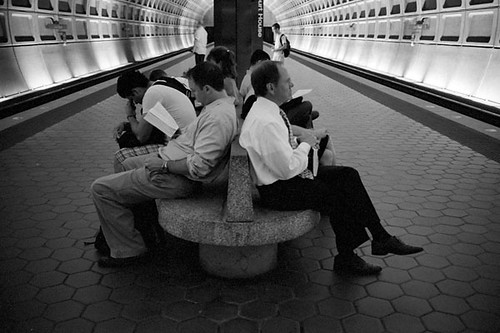WMATA is having one hell of a bad day, nay, bad month, that just happens to be capped by a really bad day. We’ve had multiple Metrorail outages today, on the Red, Yellow, Orange, and now all Metrorail lines. And who knows how many escalators are out.
You can blame the high heat. You can blame the creaking system. You can even blame power companies, both Pepco and Dominion. But don’t blame the record high ridership. In fact, wonder why Metrorail has such problems with such low ridership.
First, listen to Metrorail croon about its fiscal 2008 ridership:
For the third consecutive year, more than 200 million people rode the Metrorail system during a fiscal year, and for the 12th consecutive year ridership increased on the rail system.
In fiscal year 2008 (July 1, 2007, through June 30, 2008), 215,314,956 customers went through the faregates, a 3.6 percent increase, or 7 million more customers than fiscal year 2007
Sounds impressive, eh? Like you might be more crowded on the trains when they do run. That’s until you realize that back in the 1970’s, the system was designed for 323 million annual riders.
So, rather than being grossly overcrowded, Metrorail is actually grossly under ridden – 108 million riders short of its expected volume – or only 2/3 of the capacity it was supposedly designed for. And yet, even with 1/3 more design capacity WMATA can barely keep trains running at all, much less on time.
As you imagine a third more passengers crammed in against you on an overcrowded car, all I can say is: thank god those projections were so off, else we’d all be going to hell on Metrorail.
Hat tip to DC City Desk to keep Metrorail in perspective.

I’d like to see if how the source for the 323 million calculated that figure. Yes, Metrorail is pretty packed right now during rush hour. From my own experience, the red line is packed in the downtown core during rush hour, and that clearly is getting close to reaching capacity.
However, there’s usually some room as one rides out farther out of DC. There’re also far fewer riders during off-peak hours. Metro could probably handle more riders in off-peak hours, if there were the demand for it.
Now, getting through the downtown core, is another matter. I don’t know if the 323 million number assumed that there would be much more ridership within the downtown core (and that ridership is not spread out evenly throughout the whole system).
…or to put it more simply, it may be more accurate to say that Metro is running at closer to capacity during rush hours but running with plenty of extra capacity during off-peak hours. So yes, more ridership during peak hours would be madness; but during off-peak hours, Metro could handle it if it adjusted its schedules accordingly.
Indeed, mere capacity information doesn’t tell us when the capacity is stretched and when it’s not.
Doesn’t that 323 million riders figure assume all 8 car trains all the time? I thought that figure was the designed capacity of the tracks and stations, not that we should be able to move that many given the current number of trains.
Did anyone check the Blue/Orange lines yesterday. They had a switch track outage caused by a computer. It kind of sucks to be waiting all of that time, but at least they, for the most part are reliable. They just need to improve a little.
Would it be cost effective if Metro ran more trains off-peak, but only 2 or 3 car trains? They would have to hire more train operators, but they might increase ridership if people know they won’t ever have to wait 20 minutes for the first train and then 20 minutes for the transfer (which I had to do when I took a class that always ended so I just missed the previous train). Or Metro could hold trains at transfer stations so that passengers from each could make the transfer — like in Chicago.